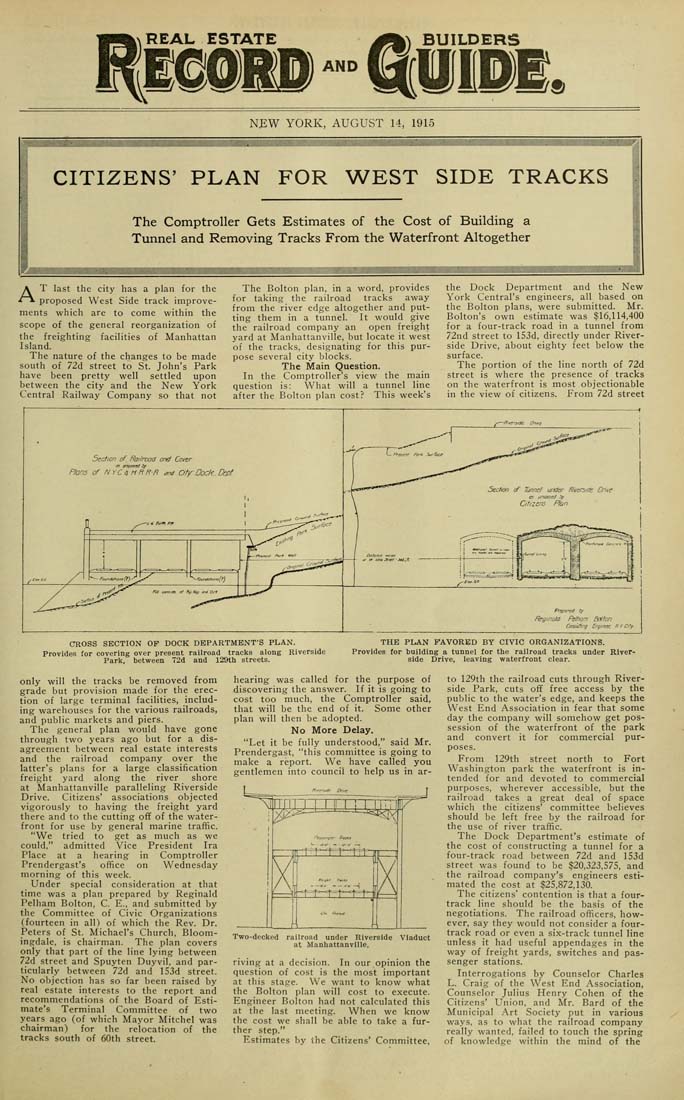Columbia University Libraries Digital Collections: The Real Estate Record
Use your browser's Print function to print these pages.
Real estate record and builders' guide: [v. 96, no. 2474: Articles]: August 14, 1915

Text version:
Please note: this text may be incomplete. For more information about this OCR, view About OCR text.
m REAL ESTATE AND ^^ BUILDERS NEW YORK, AUGUST 14, 1915 ■■lllllllillli ■Ililllllli I CITIZENS' PLAN FOR WEST SIDE TRACKS The Comptroller Gets Estimates of the Cost of Building a Tunnel and Removing Tracks From the Waterfront Altogether Klillill AT last the city has a plan for the proposed West Side track improve¬ ments which are to come within the scope of the general reorganization of the freighting facilities of Manhattan Island. The nature of the changes to be made south of 72d street to St. John's Park have been pretty well settled upon between the city and the New York Central Railway Company so that not The Bolton plan, in a word, provides for taking the railroad tracks away from the river edge altogether and put¬ ting them in a tunnel. It would give the railroad company an open freight yard at Manhattanville, but locate it west of the tracks, designating for this pur¬ pose several city blocks. The Main Question. In the Comptroller's view the main question is: What will a tunnel line after the Bolton plan cost? This week's the Dock Department and the New York Central's engineers, all based on the Bolton plans, were submitted. Mr. Bolton's own estimate was $16,114,400 for a four-track road in a tunnel from 72nd street to lS3d, directly under River¬ side Drive, about eighty feet below the surface. The portion of the line north of 72d street is where the presence of tracks on the waterfront is most objectionable in the view of citizens. From 72d street CROSS SECTION OF DOCK DEPARTMENT'S PLAN. Provides for covering over present railroad tracks along Riverside Park, between 72d and 129th streets. THE PLAN FAVORED BY CIVIC ORGANIZATIONS. Provides for building a tunnel for the railroad tracks under River¬ side Drive, leaving waterfront clear. only will the tracks be removed from grade but provision made for the erec¬ tion of large terminal facilities, includ¬ ing warehouses for the various railroads, and public markets and piers. The general plan would have gone through two years ago but for a dis¬ agreement between real estate interests and the railroad company over the latter's plans for a large classification freight yard along the river shore at Manhattanville paralleling Riverside Drive. Citizens' associations objected vigorously to having the freight yard there and to the cutting oflf of the water¬ front for use by general marine traffic. "We tried to get as rnuch as we could," admitted Vice President Ira Place at a hearing in Comptroller Prendergast's office on Wednesday morning of this week. Under special consideration at that time was a plan prepared by Reginald Pelham Bolton, C. E., and submitted by the Committee of Civic Organizations (fourteen in all) of which the Rev. Dr. Peters of St. Michael's Church, Bioom¬ ingdale, is chairman. The plan covers only that part of the line lying between 72d street and Spuyten Duyvil, and par¬ ticularly between 72d and 153d street. No objection has so far been raised by real estate interests to the report and recommendations of the Board of Esti¬ mate's Terminal Committee of two years ago (of which Mayor Mitchel was chairman) for the relocation of the tracks south of 60th street. hearing was called for the purpose of discovering the answer. If it is going to cost too much, the Comptroller said, that will be the end of it. Some other plan will then be adopted. No More Delay. "Let it be fully understood," said Mr. Prendergast, "this committee is going to make a report. We have called you gentlemen into council to help us in ar- ■•r...-.../f z^.f Two-decked railroad under Riverside Viaduct at Manhattanville. riving at a decision. In our opinion the question of cost is the most important at this stage. We want to know what the Bolton plan will cost to execute. Engineer Bolton had not calculated this at the last meeting. When we know the cost we shall be able to take a fur¬ ther step." Estimates by the Citizens' Committee, to 129th the railroad cuts through River¬ side Park, cuts ofif free access by the public to the water's edge, and keeps the West End Association in fear that some day the company will somehow get pos¬ session of the waterfront of the park and convert it for commercial pur¬ poses. From 129th street north to Fort Washington park the waterfront is in¬ tended for and devoted to commercial purposes, wherever accessible, but the railroad takes a great deal of space which the citizens' committee believes should be left free by the railroad for the use of river traffic. The Dock Department's estimate of the cost of constructing a tunnel for a four-track road between 72d and 153d street was found to be $20,323,575, and the railroad company's engineers esti¬ mated the cost at $25,872,130. The citizens' contention is that a four- track line should be the basis of the negotiations. The railroad officers, how¬ ever, say they would not consider a four- track road or even a si.x-track tunnel line unless it had useful appendages in the way of freight yards, switches and pas¬ senger stations. Interrogations by Counselor Charles L. Craig of the West End Association, Counselor Julius Henry Cohen of the Citizens' Union, and Mr. Bard of the Municipal Art Society put in various ways, as to what the railroad company really wanted, failed to touch the spring of knowledge within the mind of the